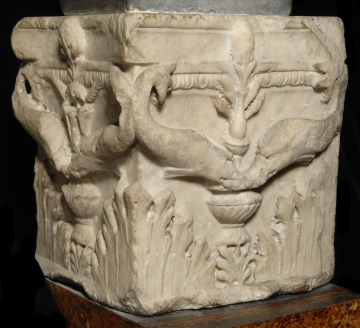Explore Collections


You are here:
CollectionsOnline
/
Capital of a deep pilaster
Browse
Capital of a deep pilaster
Early 2nd century
Luna marble
Height: 23cm
Width: 23cm
Thickness: 22cm
Width: 23cm
Thickness: 22cm
Museum number: M565
On display: Museum South Passage
All spaces are in No. 13 Lincoln's Inn Fields unless identified as in No. 12, Soane's first house.
For tours https://www.soane.org/your-visit
Curatorial note
The enrichment of the three carved sides consists in each case of wide, concave abacus, fillet, and egg and tongue above inverted dolphins, tails forming the corner "volutes" and heads joined at the top of a vase. This enriched vase is set on a small palmette and a foliate pattern springs from it, terminating in a flower on the abacus centre. The corners are sheathed in acanthus, and there is a rolled fillet moulding (mostly broken away) at the base. Earlier second century work; possibly from a sepulchral monument, as suggested by the general analogy of the two later first century, pinecone-topped terminal capitals in Aquileia2 .
For a slightly more elaborate and perhaps a trifle larger pendant to this small capital, compare the example illustrated by Piranesi in Le antichità Romane3 . Since the scene etched is a combination of monuments and no reference is given, it is impossible to tell from whence the capital came [the capital is marked with the letter G, iscription needs to be checked]. Ronczewski4 stresses the pan-Italic unity of this style of Hadrianic carving by illustrating a number of dolphin capitals and pilasters, from Padua, Nocera, and Rome. Quite close to the Soane example is a somewhat smaller pilaster capital built into the wall of the Lateran Museum (fig.10). Deep pilaster capitals from this set, or close copies thereof, were used as aedicula supports on more than one Renaissance tomb in Rome (e.g. that of Cardinal Antoniotto Pallavicini, S.M. del Popolo5 ).
1 J. Wilton-Ely, Giovanni Battista Piranesi: The Complete Etchings - an Illustrated Catalogue, no. 779.
2 V. Scrinari, I Capitelli romani di Aquileia, Padua, 1952, nos. 59, 60.
3 G.B. Piranesi, Le Antichità Romane, vol. II, pl. LXIII. Wilton-Ely, no. 420.
4 Anzeiger (Jahrbuch des Deutschen Archaologischen Instituts), 1933, cols. 408 ff., figs. 6-10.
5 Davies, Renaissance Tombs of Rome, p. 300f.; Windsor Drawings, vol. 201, nos. 11, 740, etc.
For a slightly more elaborate and perhaps a trifle larger pendant to this small capital, compare the example illustrated by Piranesi in Le antichità Romane3 . Since the scene etched is a combination of monuments and no reference is given, it is impossible to tell from whence the capital came [the capital is marked with the letter G, iscription needs to be checked]. Ronczewski4 stresses the pan-Italic unity of this style of Hadrianic carving by illustrating a number of dolphin capitals and pilasters, from Padua, Nocera, and Rome. Quite close to the Soane example is a somewhat smaller pilaster capital built into the wall of the Lateran Museum (fig.10). Deep pilaster capitals from this set, or close copies thereof, were used as aedicula supports on more than one Renaissance tomb in Rome (e.g. that of Cardinal Antoniotto Pallavicini, S.M. del Popolo5 ).
1 J. Wilton-Ely, Giovanni Battista Piranesi: The Complete Etchings - an Illustrated Catalogue, no. 779.
2 V. Scrinari, I Capitelli romani di Aquileia, Padua, 1952, nos. 59, 60.
3 G.B. Piranesi, Le Antichità Romane, vol. II, pl. LXIII. Wilton-Ely, no. 420.
4 Anzeiger (Jahrbuch des Deutschen Archaologischen Instituts), 1933, cols. 408 ff., figs. 6-10.
5 Davies, Renaissance Tombs of Rome, p. 300f.; Windsor Drawings, vol. 201, nos. 11, 740, etc.
Rome; collected in Rome by Charles Heathcote Tatham for the architect Henry Holland during the 1790s. See Cornelius Vermeule, unpublished catalogue of the Antiquities at Sir John Soane's Museum, Introduction, transcription of Tatham letters, List 3, no.3. (Soane Archive). Probably Piranesi, De Romanorum magnificentia et architectura, (1761) Tab. XIX, No. 41 , "In vinea Borionia ad Portam Salarium" (near the modern Piazza Fiume at the end of the Via Piave).
Literature
Tatham: Etchings, 7; Drawings, 8.
Description of Sir John Soane's Museum, 1930, fig.51.
Description of Sir John Soane's Museum, 1930, fig.51.
Soane collections online is being continually updated. If you wish to find out more or if you have any further information about this object please contact us: worksofart@soane.org.uk


